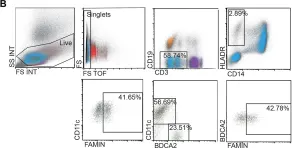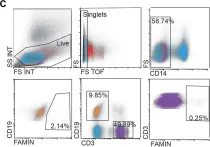Deciphering the origins of innate lymphoid cells (ILCs) is critical for a deeper understanding of innate immunity. Here, we present a protocol for assessing ILC potential of human embryonic resources. We describe steps for identifying lymphoid progenitors in human embryonic tissues, then culturing mature ILCs in vitro, and identifying characteristics and functions of different cultured ILC subsets using cellular indexing of transcriptomes and epitopes (CITE)-sequencing and flow cytometry analysis. This protocol provides a simple platform for investigating the development of human embryonic ILCs. For complete details on the use and execution of this protocol, please refer to Ni et al.1.
Copyright © 2024 The Author(s). Published by Elsevier Inc. All rights reserved.
Product Citations: 80
Protocol for in vitro generation of innate lymphoid cells from human embryonic tissues.
In STAR Protocols on 21 March 2025 by Liu, C., Fu, Q., et al.
-
Stem Cells and Developmental Biology
In Veterinary Research on 18 December 2024 by Huang, N., Ye, L., et al.
Diarrhoea and preweaning mortality in piglets are crucial factors impacting the economic sustainability of the swine industry. Pathogenic infections are among the main causes of diarrhea and mortality. Group 3 innate lymphoid cells (ILC3s) are crucial for safeguarding against pathogenic infections. However, knowledge regarding the development and function of ILC3s in suckling piglets is currently limited. Our findings demonstrate that the development of ILC3s in suckling piglets gradually progresses from day 1 to day 21, with a notable increase observed on day 28. Additionally, the development of NKp46+ILC3s and the production of interleukin (IL)-17A by ILC3s displayed consistent patterns with the changes observed in ILC3s. Notably, interferon (IFN)-γ levels significantly increased on day 14. Moreover, the production of IFN-γ by NKp46+ILC3s was greater than that by NKp46-ILC3s. Importantly, when piglets were subjected to a 4-h challenge with enterotoxigenic Escherichia coli, both the percentages of ILC3s significantly increased, accompanied by increased IL-22 production, highlighting their importance in maintaining intestinal health. The outcomes of this study provide valuable insights for future related research.
© 2024. The Author(s).
-
Immunology and Microbiology
-
Stem Cells and Developmental Biology
-
Veterinary Research
Synergistic and antagonistic activities ofIRF8andFOSenhancer pairs during an immune cell fate switch
Preprint on BioRxiv : the Preprint Server for Biology on 19 September 2024 by Klonizakis, A., Alcoverro-Bertran, M., et al.
Cell-fate instructive genes tend to be regulated by large clusters of enhancers. Whether and how individual enhancers within such clusters cooperate in regulating gene expression is poorly understood. We have previously developed a computational method, SEGCOND, that identifies hubs consisting of enhancer clusters and their target genes, termed Putative Transcriptional Condensates (PTCs). Using SEGCOND, we identified PTCs in a CEBPA-induced B-cell to macrophage transdifferentiation system. We found them to be enriched for highly expressed, lineage-restricted genes and to associate with BRD4, a component of transcriptional condensates. Here we performed single and combinatorial deletions of enhancers within two active PTCs after transdifferentiation is induced, harboring IRF8 and FOS . Two enhancers within the IRF8 PTC were found to form a backup mechanism when combined, safeguarding IRF8 expression and transdifferentiation kinetics. Unexpectedly, two individual enhancers within the FOS PTC antagonize each other at Day 1 of transdifferentiation, delaying the conversion of B-cells to macrophages and reducing FOS expression, but cooperate to increase FOS levels in Day 7 induced cells. Our results reveal differentiation stage-specific, complex interactions, between individual enhancers within a cluster.
-
Immunology and Microbiology
-
Stem Cells and Developmental Biology
An activity-specificity trade-off encoded in human transcription factors.
In Nature Cell Biology on 1 August 2024 by Naderi, J., Magalhaes, A. P., et al.
Transcription factors (TFs) control specificity and activity of gene transcription, but whether a relationship between these two features exists is unclear. Here we provide evidence for an evolutionary trade-off between the activity and specificity in human TFs encoded as submaximal dispersion of aromatic residues in their intrinsically disordered protein regions. We identified approximately 500 human TFs that encode short periodic blocks of aromatic residues in their intrinsically disordered regions, resembling imperfect prion-like sequences. Mutation of periodic aromatic residues reduced transcriptional activity, whereas increasing the aromatic dispersion of multiple human TFs enhanced transcriptional activity and reprogramming efficiency, promoted liquid-liquid phase separation in vitro and more promiscuous DNA binding in cells. Together with recent work on enhancer elements, these results suggest an important evolutionary role of suboptimal features in transcriptional control. We propose that rational engineering of amino acid features that alter phase separation may be a strategy to optimize TF-dependent processes, including cellular reprogramming.
© 2024. The Author(s).
-
Biochemistry and Molecular biology
-
Cell Biology
Injection Drug Use Alters Plasma Regulation of the B Cell Response.
In Cells on 10 June 2024 by Sarkar, S., Hill, D. D., et al.
The opioid epidemic continues to be a major public health issue that includes millions of people who inject drugs (PWID). PWID have increased incidence of serious infections, including HIV as well as metabolic and inflammatory sequelae. We sought to discern the extent of systemic alterations in humoral immunity associated with injection drug use, including alterations in the plasma proteome and its regulation of B cell responsiveness. Comprehensive plasma proteomics analysis of HIV negative/hepatitis C negative individuals with a history of recent injection heroin use was performed using mass spectrometry and ELISA. The effects of plasma from PWID and healthy controls on the in vitro proliferation and transcriptional profile of B cell responses to stimulation were determined by flow cytometry and RNA-Seq. The plasma proteome of PWID was distinct from healthy control individuals, with numerous immune-related analytes significantly altered in PWID, including complement (C3, C5, C9), immunoglobulin (IgD, IgM, kappa light chain), and other inflammatory mediators (CXCL4, LPS binding protein, C-reactive protein). The plasma of PWID suppressed the in vitro proliferation of B cells. Transcriptome analysis indicated that PWID plasma treatment increased B cell receptor and CD40 signaling and shifted B cell differentiation from plasma cell-like toward germinal center B cell-like transcriptional profiles. These results indicate that the systemic inflammatory milieu is substantially altered in PWID and may impact their B cell responses.
-
Homo sapiens (Human)
-
Cell Biology
-
Immunology and Microbiology
In PLoS One on 14 December 2016 by Assadi, G., Vesterlund, L., et al.
Fig.4.B

-
FC/FACS
-
Homo sapiens (Human)
Collected and cropped from PLoS One by CiteAb, provided under a CC-BY license
Image 1 of 2
In PLoS One on 14 December 2016 by Assadi, G., Vesterlund, L., et al.
Fig.4.C

-
FC/FACS
-
Homo sapiens (Human)
Collected and cropped from PLoS One by CiteAb, provided under a CC-BY license
Image 1 of 2

